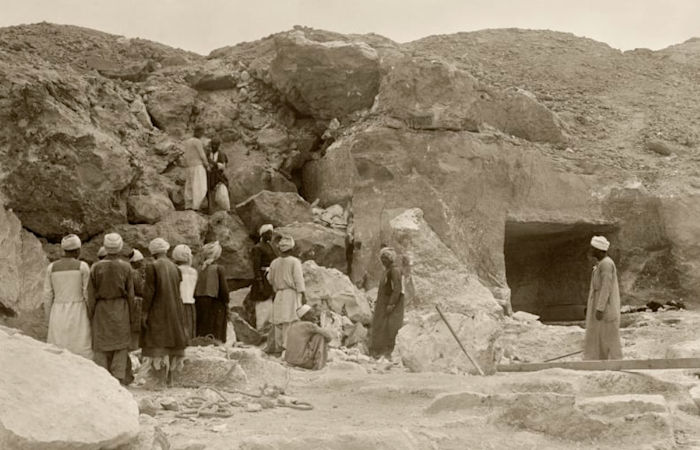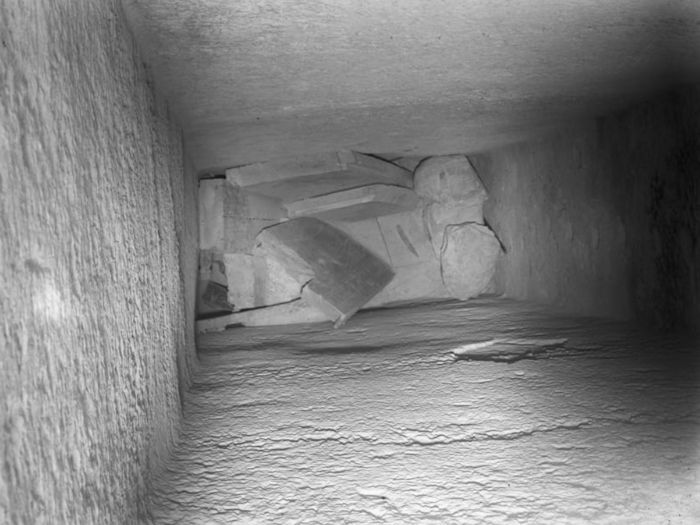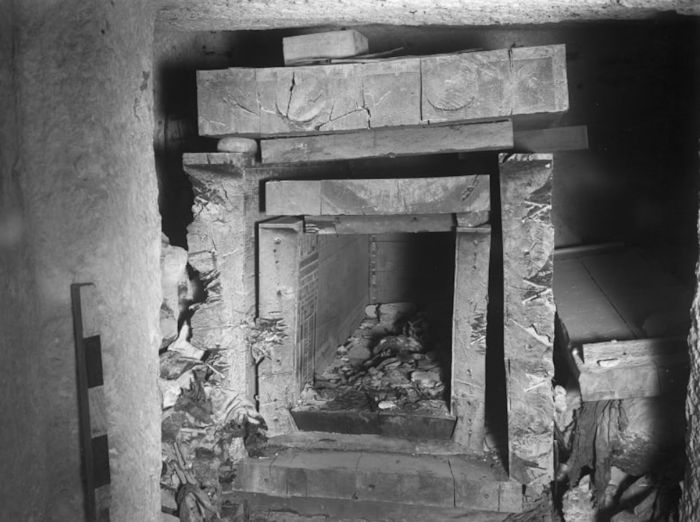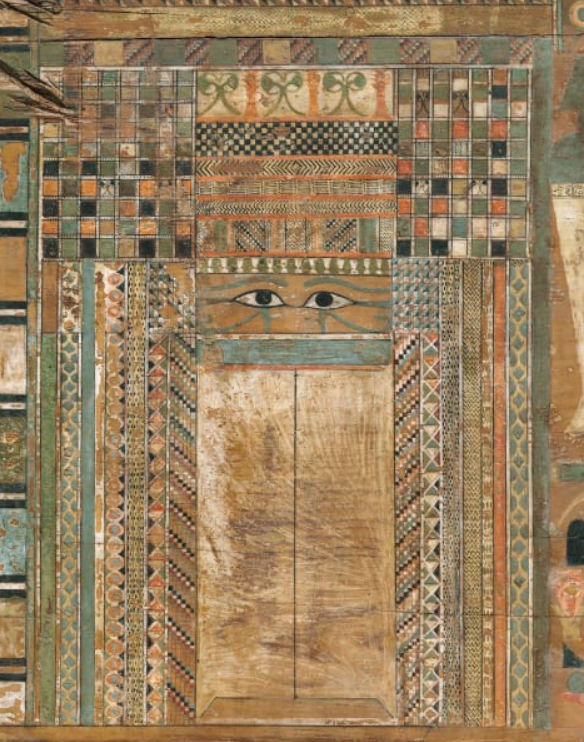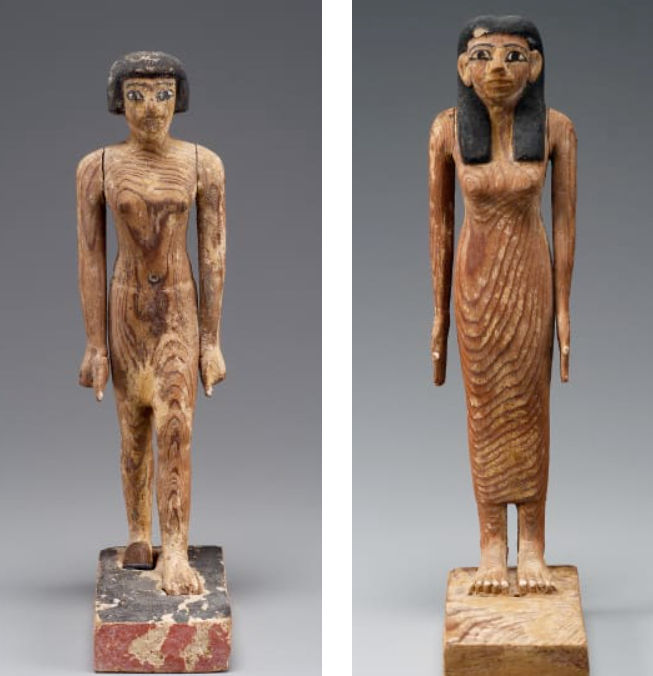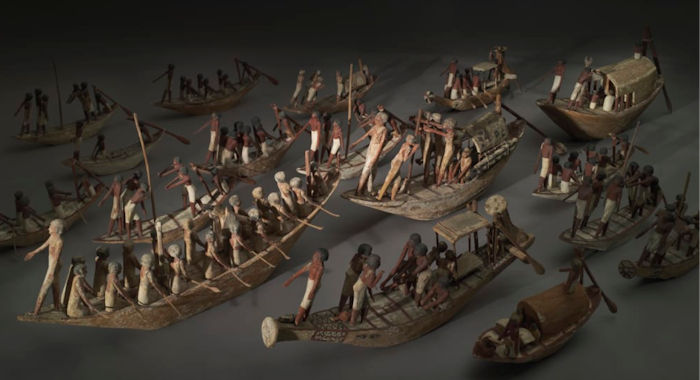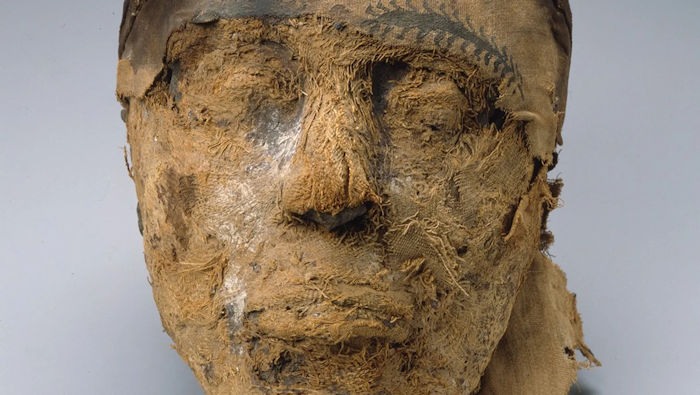Mystery Of Egyptian Tomb 10A And The Mummy’s Head – A 4,000-Year-Old Crime
Ellen Lloyd - AncientPages.com - All ancient Egyptian tombs are unique, but some pose a greater mystery than others.
In 1905, archaeologists excavating in the Egyptian necropolis of Deir el-Bersha discovered a hidden tomb that contained something unexpected. After 33 days of digging a 30-foot shaft, the archaeological team, led by archaeologists George Reisner and Hanford Lyman Story from the Harvard University-Boston Museum of Fine Arts Expedition, entered the 4,000-year-old Egyptian tomb, but they were unprepared for the frightening sight that awaited them. Inside the cramped limestone chamber was a beautifully painted cedar coffin, and on top of it was a mummy's severed head.
Riddle Of The Decapitated Egyptian Mummy
Where was the rest of the mummy? Why was only the head there? Who and why had beheaded the deceased? Decapitation was not an ancient Egyptian burial practice anyone was familiar with at the time. The researchers had encountered a mystery, and it would take 104 years before modern forensic experts could shed some light on this peculiar story.
As archaeologists continued exploring the hidden tomb's secrets, they realized this was no ordinary burial site.
Djehutynakht's tomb was discovered at the bottom of a 30ft pit. It had been plundered in antiquity, and the corpses damaged. Most of the valuable jewels were stolen, but a number of objects were left behind, making it one of the largest burial assemblages of the Middle Kingdom ever discovered. Courtesy of Museum of Fine Arts, Boston
Tomb 10A was the largest burial assemblage of the Middle Kingdom (2040-1640 B.C.) ever discovered. Scientists found magnificent cedarwood coffins, personal items such as jewelry, written religious chants, and an astounding flotilla of reassembled model boats inside the chamber. As the investigation of tomb 10A continued, researchers eventually determined this was the final resting place for a governor named Djehutynakh and his wife.
"At some point during the couple's 4,000-year-long slumber, grave robbers ransacked their burial chamber and plundered its gold and jewels. The looters tossed a headless, limbless mummified torso into a corner before attempting to set the room on fire to cover their tracks." 1
The tomb contained four painted coffins, an inner and outer one for both the governor and his wife. They were made of massive planks of imported cedar. Courtesy of Museum of Fine Arts, Boston
The archaeologists felt lucky because they could recover many magnificent ancient objects that had survived the raid and sent them to the Museum of Fine Arts, Boston, in 1921.
According to the Museum of Fine Arts, Boston, tomb 10 A "contained four beautifully painted coffins, one of which (detail, shown above), the famous "Bersha coffin" (the outer coffin of the governor), is arguably the finest painted coffin Egypt produced and a masterpiece of panel painting. The tomb also included Djehutynakht's walking sticks, pottery, canopic jar, and miniature wooden models that were made for the burial but reflect life on Djehutynakht's estate, including some 58 model boats and nearly three dozen models of daily life such as individual shops for carpenters, weavers, brick-makers, bakers, and brewers. Of these, the best known is the exquisitely carved "Bersha procession" of a male priest leading female offering bearers." 2
The outer coffin of Djehutynakht, known as the "Bersha coffin" is famous for its intricate and beautiful panel painting. The paintings and inscribed funerary texts were intended to facilitate Djehutynakht's passage to the afterlife. Courtesy of Museum of Fine Arts, Boston
The transportation of these ancient items was dramatic because the ship caught fire. Still, fortunately, the crew had the situation under control, and the precious ancient Egyptian artifacts suffered only slight water damage.
After arriving in Boston, the Museum put the Deir el-Bersha coffin and procession on view in the galleries, but most of the other objects were not revealed to the public.
Statuettes were found within the tomb. Right: This wooden figure of a striding man is thought to be Governor Djehutynakht. Courtesy of Museum of Fine Arts, Boston - Left: A female figure was also found, thought to be Lady Djehutynakht. These funerary figurines, shawabtys, were meant to act as a substitute for the dead in the afterlife, when the gods asked them to perform menial tasks. Courtesy of Museum of Fine Arts, Boston
In 2009, the Museum of Boston decided to put the stored artifacts on display, but the staff encountered a rather embarring problem. "Though the torso remained in Egypt, the decapitated head became the star of the showcase. With its painted-on eyebrows, somber expression, and wavy brown hair peeking through its tattered bandages, the mummy's noggin brought viewers face-to-face with a mystery." 1
Whose Head Was It And Why Was It Missing Cheek Bones?
Suddenly, the Museum realized no one knew whether the mummified head belonged to Djehutynakh or his wife. Only a DNA analysis could answer this question, but extracting DNA from a 4,000-year-old mummy is easier said than done.
The tomb included some 58 model boats, as well as models of carpenters, weavers, brick-makers, bakers and brewers. Courtesy of Museum of Fine Arts, Boston
The Boston Museum contacted the Federal Bureau of Investigation (F.B.I.), asking for help solving this ancient mystery.
While examining the head, scientists discovered something puzzling. The mummified head was missing cheekbones and part of its jaw hinge. How could the missing facial bones be explained?
According to Dr. Rajiv Gupta, a neuroradiologist at Massachusetts General, "all the muscles that are involved in chewing and closing the mouth, the attachment sites of those muscles had been taken out."
For years, archaeologists had puzzled over whether the mummy's head belonged to husband or wife. The Boston Museum of Fine Arts, in possession of the entire contents of the tomb, sent it out for analysis. In 2009, doctors from the Massachusetts General Hospital extracted a tooth from the mummified head. Courtesy of Museum of Fine Arts, Boston
This had been caused by the opening of the mouth ceremony, an ancient Egyptian ritual described in funerary texts such as the Pyramid Texts. "The Opening of the Mouth Ceremony allowed statues of deities and the dead to regain their senses, to see thereby into the realm of the living." 3
However, the ritual was also performed so the deceased could eat, drink and breathe in the afterlife.
By extracting the mummy's molar and studying the genetic material, F.B.I specialists could determine the mummified severed head belonged to Governor Djehutynakht.
What is still unknown and may never be solved is why Governor Djehutynakht had been decapitated and by whom. Had the ancient Egyptian governor been a hated man? Did looters deliberately cut off his head to prevent him from entering the afterlife, or did workers destroy his body before the tomb was sealed?
Updated on September 2, 2023
Written by Ellen Lloyd – AncientPages.com
Copyright © AncientPages.com All rights reserved. This material may not be published, broadcast, rewritten or redistributed in whole or part without the express written permission of AncientPages.com
Expand for references- Nicholas St. Fleur - The F.B.I. and the Mystery of the Mummy's Head, The New York Times
- Museum of Fine Arts, Boston - The Secrets of Tomb 10A Egypt 2000 BC
- Carolyn Graves- Brown - Daemons and Spirits in Ancient Egypt
More From Ancient Pages
-
 Rasputin – Controversial Mystic With Healing Powers – An Evil Or Misunderstood Man?
Featured Stories | Aug 4, 2018
Rasputin – Controversial Mystic With Healing Powers – An Evil Or Misunderstood Man?
Featured Stories | Aug 4, 2018 -
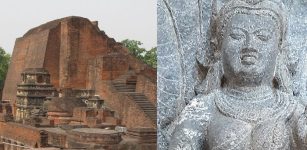 Unique 1,300-Year-Old Pala Period Idol Of Snake Goddess, Nag Devi Discovered Near Nalanda University, India
Archaeology | Apr 5, 2022
Unique 1,300-Year-Old Pala Period Idol Of Snake Goddess, Nag Devi Discovered Near Nalanda University, India
Archaeology | Apr 5, 2022 -
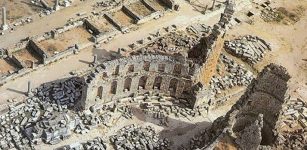 5,000-Year-Old Perga City And Kommagene Civilization: Most Of Treasures Are Still Underground
Archaeology | Dec 30, 2017
5,000-Year-Old Perga City And Kommagene Civilization: Most Of Treasures Are Still Underground
Archaeology | Dec 30, 2017 -
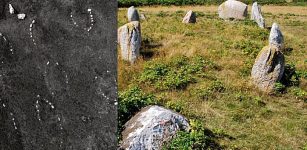 Mystery Of Viking Ship Burials In Hjarnø, Denmark And Their Unusual Design
Archaeology | Jun 1, 2021
Mystery Of Viking Ship Burials In Hjarnø, Denmark And Their Unusual Design
Archaeology | Jun 1, 2021 -
 Babylonians And Sumerians Had Advanced Knowledge Of Astronomy
Civilizations | Feb 28, 2017
Babylonians And Sumerians Had Advanced Knowledge Of Astronomy
Civilizations | Feb 28, 2017 -
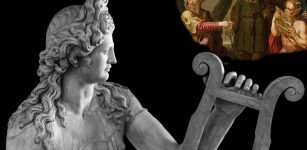 Apollo Punished Rivals For Their Extraordinary Musical Skills
Featured Stories | Apr 19, 2022
Apollo Punished Rivals For Their Extraordinary Musical Skills
Featured Stories | Apr 19, 2022 -
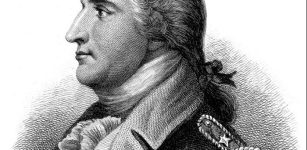 On This Day In History: American General Benedict Arnold Commits Treason – On Sep 21, 1780
News | Sep 21, 2016
On This Day In History: American General Benedict Arnold Commits Treason – On Sep 21, 1780
News | Sep 21, 2016 -
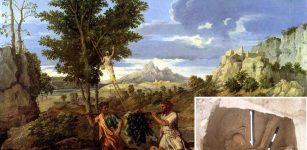 Mysterious Biblical Canaanites – What Ancient DNA Reveals About Their Fate
Archaeology | Jul 28, 2017
Mysterious Biblical Canaanites – What Ancient DNA Reveals About Their Fate
Archaeology | Jul 28, 2017 -
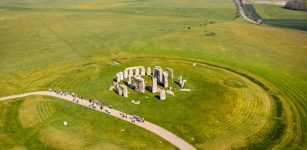 Controversial Tunnel Plan Near Stonehenge Gets U.K. Government Approval – Shocked And Angry Opponents Will Challenge The Decision In High Court
News | Nov 13, 2020
Controversial Tunnel Plan Near Stonehenge Gets U.K. Government Approval – Shocked And Angry Opponents Will Challenge The Decision In High Court
News | Nov 13, 2020 -
 Giant 4,500-Year-Old Axe Grinding Site Discovered In Scotland
Archaeology | Dec 13, 2022
Giant 4,500-Year-Old Axe Grinding Site Discovered In Scotland
Archaeology | Dec 13, 2022 -
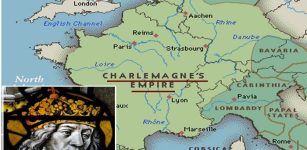 On This Day In History: Charlemagne Became The King Of The Franks – On Dec 5, 771
News | Dec 5, 2016
On This Day In History: Charlemagne Became The King Of The Franks – On Dec 5, 771
News | Dec 5, 2016 -
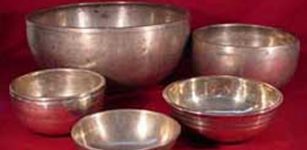 Sound Healing And Crystal Therapy, Ancient Arts Being Practiced Today – What Does Science Say?
Featured Stories | Mar 25, 2017
Sound Healing And Crystal Therapy, Ancient Arts Being Practiced Today – What Does Science Say?
Featured Stories | Mar 25, 2017 -
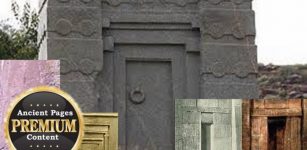 Unraveling The Mystery Of Ancient ‘False Doorways’
Ancient Mysteries | May 24, 2014
Unraveling The Mystery Of Ancient ‘False Doorways’
Ancient Mysteries | May 24, 2014 -
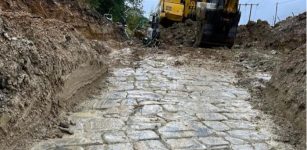 Hidden 2,000-Year-Old Roman Road Uncovered In Worcestershire Could Be Of ‘Global Importance’
Archaeology | Nov 12, 2022
Hidden 2,000-Year-Old Roman Road Uncovered In Worcestershire Could Be Of ‘Global Importance’
Archaeology | Nov 12, 2022 -
 Extremely Rare 2,700-Year-Old Black Stone Seal Depicting A Winged Genie Discovered In Jerusalem
Archaeology | Sep 2, 2024
Extremely Rare 2,700-Year-Old Black Stone Seal Depicting A Winged Genie Discovered In Jerusalem
Archaeology | Sep 2, 2024 -
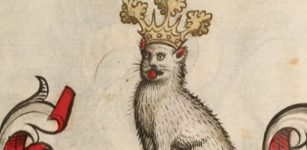 Cats In The Middle Ages: What Medieval Manuscripts Teach Us About Our Ancestors’ Pets
Featured Stories | Dec 24, 2022
Cats In The Middle Ages: What Medieval Manuscripts Teach Us About Our Ancestors’ Pets
Featured Stories | Dec 24, 2022 -
 Ancient Mystery Of The Before – Time People – Traces Of An Unknown Lost Race – Part 1
Ancient Mysteries | Apr 3, 2019
Ancient Mystery Of The Before – Time People – Traces Of An Unknown Lost Race – Part 1
Ancient Mysteries | Apr 3, 2019 -
 Sacred City Of Caral – Site Of The Oldest Known Civilization In The Americas
Civilizations | Aug 28, 2018
Sacred City Of Caral – Site Of The Oldest Known Civilization In The Americas
Civilizations | Aug 28, 2018 -
 On This Day In History: Naval Battle Of Rennell Island Fought Off Guadalcanal – On Jan 29, 1943
News | Jan 29, 2017
On This Day In History: Naval Battle Of Rennell Island Fought Off Guadalcanal – On Jan 29, 1943
News | Jan 29, 2017 -
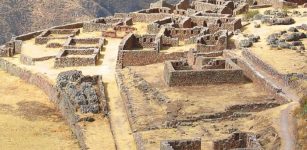 Beautiful Ancient City Of Pisac In The Sacred Valley, Peru – Incredible Inca Ruins
Featured Stories | Jun 22, 2017
Beautiful Ancient City Of Pisac In The Sacred Valley, Peru – Incredible Inca Ruins
Featured Stories | Jun 22, 2017

